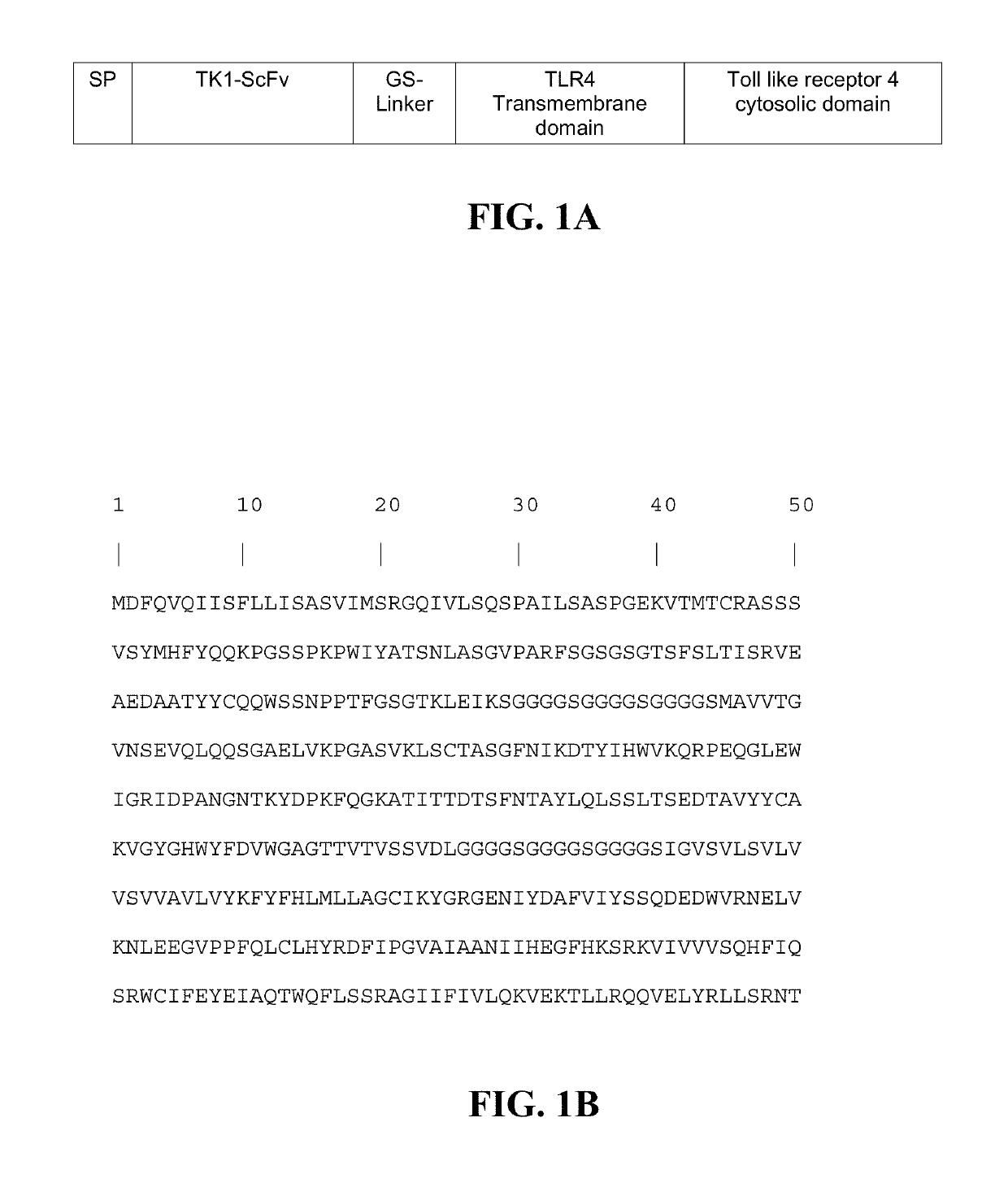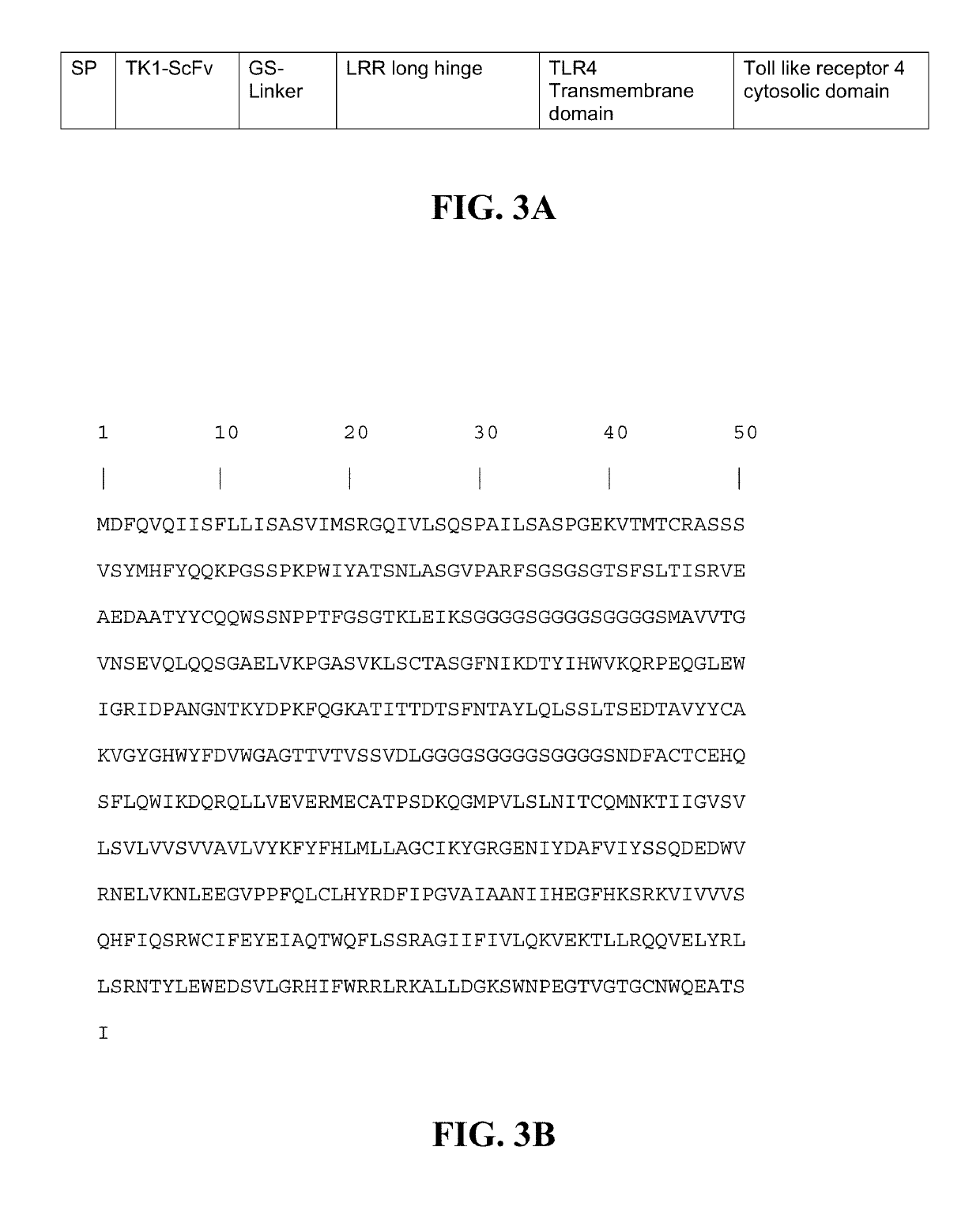Transgenic macrophages, chimeric antigen receptors, and associated methods
a technology of chimeric antigen receptors and transgenic macrophages, applied in the field of biotechnology, can solve the problems of adversely affecting malignancy progression and metastasis, and the side effects are typically too sever
- Summary
- Abstract
- Description
- Claims
- Application Information
AI Technical Summary
Benefits of technology
Problems solved by technology
Method used
Image
Examples
example 1
Isolation of ScFv Fragments for Specific Ligands
[0208]cDNA was purified from a monoclonal antibody hybridoma cell (CB1) expressing an antibody specific to human TK1. The isolated cDNA was used to amplify the heavy and light chains of the CB1 variable region via polymerase chain reaction (PCR) Sequences from the heavy and light chain were confirmed using NCBI Blast. CB1 heavy and light chains were fused together via site overlap extension (SOE) PCR to form a single chain fragment variable (scFv) using a G4S linker. The G4S linker was codon optimized for yeast and humans using the Codon Optimization tool provided by IDT (https: / / www.idtdna.com / CodonOpt) in order to maximize protein expression. The CB1 scFv was cut out using restriction enzymes and inserted into a pMP71 CAR vector.
[0209]TK-1 and HPRT-specific human scFv fragments were isolated from a yeast antibody library. TK-1 and HPRT proteins were isolated, His-tagged, and purified. TK-1 and HPRT protein were labeled with an anti-H...
example 2
Creation of Chimeric Receptors
[0213]Construction of Chimeric Receptor Vectors:
[0214]The first step in the process is the design of the nucleotide sequences for synthetic chimeric receptor genes and the selection of appropriate lentiviral vectors. All the vector design are carried out in genious software version 9.1.6. The sequences are retrieved from the Uniprot and the Human Protein Reference Data base and NCBI as well.
[0215]Vectors are synthesized with a combination of recombinant DNA techniques and gene synthesis.
[0216]Sequences for the Single chain variable fragments are produced with a humanized antibody yeast display library or a phage display library. Nucleic acids encoding ScFv specific for each of TK1, HPRT, ROR1, MUC-16, EGFRvIII, Mesothelin, HER2, CEA, BCMA, GPC3, FAP, EphA2, NKG2D ligands, GD2, CD19, CD20, CD30, CD33, CD123, CD133, CD138, and CD171. All possible combinations of nucleic acids encoding chimeric receptors having at least one of each of a), b), c), d), and e...
example 3
Polarization of Macrophages Through Chimeric Receptors
[0226]The transduced macrophages prepared in Example 2 are separately exposed to TK1, HPRT, ROR1, MUC-16, EGFRvIII, Mesothelin, HER2, CEA, BCMA, GPC3, FAP, EphA2, NKG2D conjugated ligands, GD2, CD19, CD20, CD30, CD33, CD123, CD133, CD138, and CD171 and tested for polarization to the M1 phenotype by monitoring the secretion of IL-12 and IL-23 using a standard cytokine assay or by measuring RNA production. Macrophages bearing chimeric receptors are polarized to the M1 phenotype when exposed to the ligand specific for the particular chimeric receptor and determined by increased secretion of IL-12 and / or IL-23. Ligands other than the specific ligand for the specific chimeric receptor display no increase in IL-12 and / or IL-21.
PUM
| Property | Measurement | Unit |
|---|---|---|
| temperature | aaaaa | aaaaa |
| temperature | aaaaa | aaaaa |
| temperature | aaaaa | aaaaa |
Abstract
Description
Claims
Application Information
 Login to View More
Login to View More - R&D
- Intellectual Property
- Life Sciences
- Materials
- Tech Scout
- Unparalleled Data Quality
- Higher Quality Content
- 60% Fewer Hallucinations
Browse by: Latest US Patents, China's latest patents, Technical Efficacy Thesaurus, Application Domain, Technology Topic, Popular Technical Reports.
© 2025 PatSnap. All rights reserved.Legal|Privacy policy|Modern Slavery Act Transparency Statement|Sitemap|About US| Contact US: help@patsnap.com



